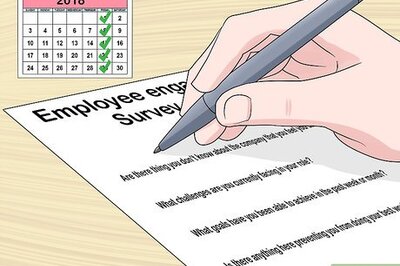
views
WASHINGTON: U.S. worker productivity increased strongly in the third quarter, though the pace of growth was likely overstated as the sharp rebound in output from the COVID-19 pandemic recession has far outpaced employment gains.
The Labor Department said on Tuesday nonfarm productivity, which measures hourly output per worker, increased at a 4.6% annualized rate last quarter. The slight downward revision from the 4.9% pace estimated last month followed a 10.6% rate of growth in the second quarter, which was the fastest since the first quarter of 1971.
The economy expanded at a historic 33.1% annualized rate in the July-September quarter, thanks to more than $3 trillion in government pandemic relief for businesses and workers. That followed a record 31.4% pace of contraction in the second quarter. Strong productivity explains the divergence between GDP growth and the labor market.
The economy has recouped two-thirds of output lost during the coronavirus crisis, while only about 56% of the 22.2 million jobs lost in March and April. A wide gap between output and employment is not unusual during recessions, with a similar trend observed during the 2007-09 Great Recession.
Economists polled by Reuters had forecast productivity growth would be unrevised at a 4.9% rate in the third quarter. The COVID-19 downturn has decimated lower-wage industries, like leisure and hospitality, which economists say tend to be less productive.
According to Moodys’ Analytics chief economist, Mark Zandi, there has been a shift in economic activity to big companies from small and medium-sized retailers. Zandi also noted that big businesses across industries are taking advantage of the pandemic to aggressively implement labor-saving technology.
“The underlying rate of productivity has not shifted from what it was before,” said Zandi. “There is no fundamental shift in productivity growth going forward, but it means it’s going to take a while to recover all the jobs lost unless we have good policy in place.”
U.S. financial markets were little moved by the data.
Compared to the third quarter of 2019, productivity increased at a 4.0% rate instead of the 4.1% pace reported last month.
Hours worked rebounded at a 37.1% rate, rather than the 36.8% rate estimated in November. That followed a record 42.9% pace of decline in the second quarter.
Unit labor costs – the price of labor per single unit of output – plunged at a 6.6% rate instead of an 8.9% rate as previously reported. Unit labor costs rose at a 12.3% pace in the second quarter. They increased at a 4.0% rate from a year ago.
“The big swings in the unit labor costs data in recent quarters make it hard to detect an underlying trend, but overall we think that the shock to the economy coming from COVID-19 should weigh on employee compensation,” said Daniel Silver, an economist at JPMorgan in New York.
Hourly compensation fell at a 2.3% rate last quarter, instead of a 4.4% pace as previously reported. That followed a 24.3% rate of acceleration in the second quarter. Compensation increased at a 8.2% rate compared to the third quarter of 2019.
Disclaimer: This post has been auto-published from an agency feed without any modifications to the text and has not been reviewed by an editor
Read all the Latest News, Breaking News and Coronavirus News here



















Comments
0 comment